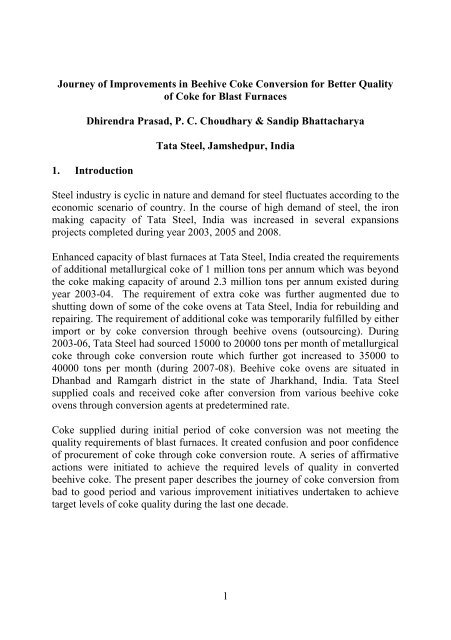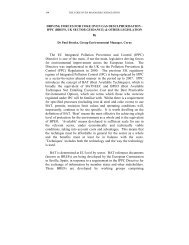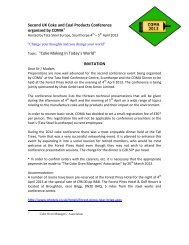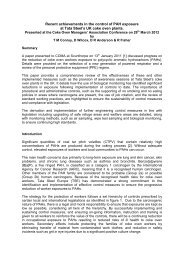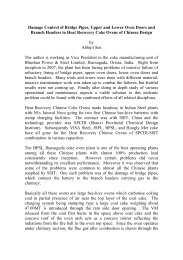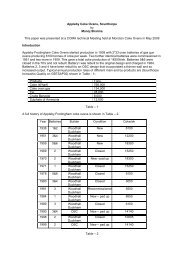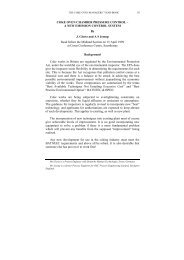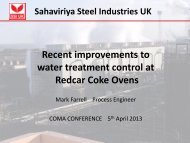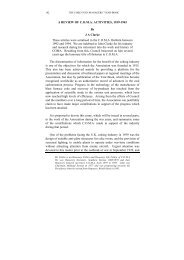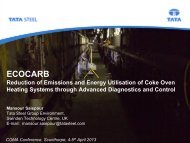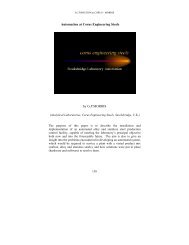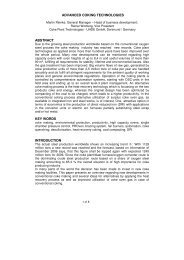THE YEAR-BOOK OF THE COKE OVEN - Coke Oven Managers ...
THE YEAR-BOOK OF THE COKE OVEN - Coke Oven Managers ...
THE YEAR-BOOK OF THE COKE OVEN - Coke Oven Managers ...
Create successful ePaper yourself
Turn your PDF publications into a flip-book with our unique Google optimized e-Paper software.
Journey of Improvements in Beehive <strong>Coke</strong> Conversion for Better Quality<br />
of <strong>Coke</strong> for Blast Furnaces<br />
Dhirendra Prasad, P. C. Choudhary & Sandip Bhattacharya<br />
1. Introduction<br />
Tata Steel, Jamshedpur, India<br />
Steel industry is cyclic in nature and demand for steel fluctuates according to the<br />
economic scenario of country. In the course of high demand of steel, the iron<br />
making capacity of Tata Steel, India was increased in several expansions<br />
projects completed during year 2003, 2005 and 2008.<br />
Enhanced capacity of blast furnaces at Tata Steel, India created the requirements<br />
of additional metallurgical coke of 1 million tons per annum which was beyond<br />
the coke making capacity of around 2.3 million tons per annum existed during<br />
year 2003-04. The requirement of extra coke was further augmented due to<br />
shutting down of some of the coke ovens at Tata Steel, India for rebuilding and<br />
repairing. The requirement of additional coke was temporarily fulfilled by either<br />
import or by coke conversion through beehive ovens (outsourcing). During<br />
2003-06, Tata Steel had sourced 15000 to 20000 tons per month of metallurgical<br />
coke through coke conversion route which further got increased to 35000 to<br />
40000 tons per month (during 2007-08). Beehive coke ovens are situated in<br />
Dhanbad and Ramgarh district in the state of Jharkhand, India. Tata Steel<br />
supplied coals and received coke after conversion from various beehive coke<br />
ovens through conversion agents at predetermined rate.<br />
<strong>Coke</strong> supplied during initial period of coke conversion was not meeting the<br />
quality requirements of blast furnaces. It created confusion and poor confidence<br />
of procurement of coke through coke conversion route. A series of affirmative<br />
actions were initiated to achieve the required levels of quality in converted<br />
beehive coke. The present paper describes the journey of coke conversion from<br />
bad to good period and various improvement initiatives undertaken to achieve<br />
target levels of coke quality during the last one decade.<br />
1
2. Description of Beehive <strong>Coke</strong> <strong>Oven</strong>s<br />
2.1 Basic design: Beehive coke ovens are very small in capacity. A battery<br />
usually consists of 12 - 16 ovens and is arranged symmetrically back to back<br />
with 6 - 8 ovens on one side. Normally the capacity of each oven varies from 5<br />
to 6.5 tons of coal charge. The capacity of beehive ovens varies from about<br />
1200 to 1600 tons coke per month per battery. A beehive oven generally<br />
consists of 2 batteries and in some cases more than 2 batteries. The structure is<br />
not exactly like a beehive but a rectangular box having an arched rooftop (figure<br />
1). The front has a door, which is fixed between channels. The oven bricks are<br />
made out of silica and there are no supporting members as in normal coke plant.<br />
There are charging holes form the top.<br />
Fig 1: Beehive <strong>Coke</strong> <strong>Oven</strong><br />
2.2 Heating system: There is no provision for external heating and it gets<br />
heated due to burning of volatile matter in the coal. The heat content of the<br />
burnt gases is utilized for heating the sole & arched rooftop. The sole is heated<br />
from bottom because of burnt hot gases pass below it. The hot burnt gases flow<br />
2
from top of the charge to two flues, located at the bottom of the sole and then<br />
through the chimney. Some oven pairs have individual chimneys while most of<br />
them have common chimney. There are coarse & fine control devices for<br />
controlling the draft in these chimneys.<br />
2.3 Coal Crushing & Charging: The top of the battery has rail tracks running<br />
along the length of the battery. Manually pushed trolleys are used for transfer &<br />
charging of coal into the ovens. Each trolley has a capacity of about 1 ton. The<br />
coal is crushed in small crushers and loaded into these trolleys. Normally 5-6<br />
trolleys filled with coal is collected on the top near the charging hole before<br />
charging is done.<br />
2.4 <strong>Coke</strong> Pushing: The front door is lifted using a winch system to open the<br />
oven. The hot coke is pulled out from the oven using a plough type of iron<br />
structure. Manual scraping is done to remove remaining portion of coke from<br />
inside the oven. The front door is lowered to close the oven. Quenching is done<br />
manually using water hosepipe on the platform where the hot coke is pulled out.<br />
2.5 Advantages & Disadvantages in Making <strong>Coke</strong> through Beehive <strong>Oven</strong>s:<br />
Advantages:<br />
1) Good quality, strong & blocky coke.<br />
2) Low capital & operating cost.<br />
3) <strong>Coke</strong> production is not connected with the availability of a market for byproducts.<br />
4) Environmental friendly as it is emission free, no handling of effluents etc.<br />
Hence creates no pollution issues.<br />
Disadvantages:<br />
1) No recovery of byproducts.<br />
2) Lower coke yield due to partial combustion.<br />
3) Production of quality coke only from good coking coals (blend of inferior<br />
coal can't be used).<br />
4) Lack of flexibility in operation.<br />
3
2.6 Specifications of Coals Supply:<br />
Specification of coal supplied by Tata Steel for conversion is shown in table 1.<br />
Coal Source Ash V.M. Moisture Coal in Blend<br />
Imported 10 % max. 23.5 %<br />
max.<br />
8 % max (may<br />
go up to 10%<br />
during<br />
monsoon)<br />
50 % or (Semi<br />
Soft - 30 %,<br />
Jellinbah- 20<br />
%)<br />
Captive<br />
(Jamadoba )<br />
17 % max. 24 % max. 9.5 % max<br />
(may go up to<br />
10% during<br />
monsoon)<br />
50 %<br />
Table 1: Specification of coal supplied by Tata Steel for conversion<br />
3. Challenges<br />
Problems were faced with respect to coke quality during initial stage of<br />
conversion of coal to coke through beehive oven route. The CSR of coke which<br />
is one of the vital parameters for coke quality was found varying significantly<br />
from ovens to ovens and even within a beehive oven battery. Also, the CSR<br />
values were low and varying in the range of 35-45. Blast furnace operators<br />
refused to charge such low CSR coke in to the blast furnaces. Therefore,<br />
challenge was taken to improve the CSR of beehive coke to above 60 as well as<br />
its consistency.<br />
As per the agreement between Tata Steel and conversion agent, maximum<br />
allowed moisture in converted beehive coke received at Jamshedpur works was<br />
10%. But, actual beehive coke moisture received at Jamshedpur works was<br />
15.1% (average). The undersize (-10 mm) in coke was approximately 3.55%.<br />
High moisture in beehive coke resulted in loss in coke yield, increased<br />
transportation cost and finally caused increase in blast furnace fuel rate. High<br />
fines in beehive coke resulted in coke yield loss and increased cost of<br />
transportation. Hence, challenge was taken to reduce beehive coke moisture by<br />
4
5% and fines (undersize) by 2% by improvements in processes for coke<br />
quenching and handling at beehive coke ovens.<br />
4. Analysis Phase<br />
A detailed cause and effect diagram (figure - 2) was prepared for a root-cause<br />
analysis of possible reasons which could lead to poor quality as well as<br />
inconsistency in the quality of coke from the beehive coke ovens.<br />
Coal<br />
Quality<br />
Operating<br />
Conditions<br />
Dispatch &<br />
receiving<br />
High Moisture<br />
High gap between pushing & charging<br />
Lack of control of air supply<br />
Deterioration on quality while loading<br />
Variability in input coal quality & Mix-ups<br />
Mode of transport<br />
Poor coking property<br />
Inadequate water for quenching<br />
Delay/early coke pushing<br />
Deterioration on quality while travel<br />
Improper crushing fineness<br />
No. of loading & receiving points<br />
Supervision<br />
Monitoring<br />
Analysis & Improvement<br />
Lack of storage facility<br />
Poor oven design conditions<br />
Inadequate control on leakage<br />
Inadequate control on air supply<br />
Improper blending<br />
Lack of instrumentation<br />
Lack of coke making knowledge<br />
Lack of blending facility<br />
Improper insulation<br />
Lack of knowledge sharing<br />
Long quenching time<br />
Non-availability of timely<br />
technical information<br />
Pilferage<br />
Sample collection & Preparation<br />
Lack of knowledge on<br />
coke quality parameters<br />
Lack of awareness<br />
training to operators<br />
Large no. of stages<br />
Sampling & quality control<br />
Standard Procedures<br />
Large no. of samples<br />
Poor <strong>Coke</strong><br />
Quality<br />
&<br />
Inconsistency<br />
Lack of instrumentation & testing facilities<br />
Process<br />
Control<br />
<strong>Oven</strong>/Process<br />
Design<br />
Knowledge<br />
& Training<br />
Inspection<br />
& Testing<br />
Fig. 2: Cause and Effect Diagram for poor quality of <strong>Coke</strong> from<br />
Beehive <strong>Coke</strong> <strong>Oven</strong>s.<br />
Most of the beehive ovens were of basic design and had no instrumentation for<br />
process control. One of major problems noticed that persons deployed as oven<br />
operators were unskilled and not aware of fundamentals of metallurgical coke<br />
making. Moreover, there was no penalty clause existed in commercial terms and<br />
conditions with conversion agents to ensure supply of good quality and quantity<br />
of coke from beehive ovens to Jamshedpur works.<br />
After thorough analysis of previous coke conversion processes, it was found that<br />
documented system was not available for coal management, carbonization and<br />
5
coke handling processes with beehive ovens operators. Written procedures were<br />
also not found for quality assurance activities like sampling, sample preparation<br />
and analysis of coal and coke. With respect to coal handling system, it was<br />
observed that no distinct demarcation was being maintained between various<br />
received coals (Semi Soft / Jamadoba/ HCC (imported hard coking coal) / WB<br />
(west bokaro) and blended coal) in the premises of beehive ovens. Different<br />
types of coal had no nameplates or display board for proper identification.<br />
Various individual coals were dumped haphazardly near the blended coal. Coals<br />
were stored in open areas which resulted in moisture gain during rains. It was<br />
also observed that process was not followed for coal usage based on the<br />
principle of “first in, first out” (FIFO) to avoid usage of weathered coal. Latest<br />
received coals were being utilized first. Crushing fineness of blended coals was<br />
inadequate. Stock management of various coals was poor.<br />
Assessment of old practices of coke quenching and handling system at beehive<br />
coke ovens was carried out. It was observed that the time elapsed between coke<br />
pushing and coal charging was very high and varying. The heat condition of the<br />
battery was poor which resulted in green coke pushing (un-carbonized / partially<br />
carbonized coke). This might led to the weakening of coke and generation of<br />
fines. Leakages through the door were noticed. In some of the ovens, whole<br />
bricks from the door were collapsed before coke pushing. Poor sealing of doors<br />
and opening of oven top covers was found in a number of ovens. Cracks on<br />
walls were also observed. Carbonization time was not being adjusted according<br />
to the coal moisture to get good quality of coke. After pushing from ovens, coke<br />
was not quenched immediately due to unpreparedness of quenching system<br />
which resulted in coke burning. Lots of green pushing was observed because of<br />
poor process control.<br />
It was observed that a single big hosepipe was being utilized for coke quenching<br />
with water. This led to requirement of more volume of water for completing the<br />
coke quenching because single stream of water could not cover entire hot coke<br />
pile at a time. This resulted in high moisture (15-17%) in dispatched coke. High<br />
moisture in coke resulted in sticking of fines on lump coke. It was also noticed<br />
that for coke quenching, uncontrolled and continuous single stage quenching<br />
operation was practiced. Quenching was being done continuously for 15-25<br />
minutes duration. Also, the quenching of coke was practiced without dispersing<br />
the red hot coke pile after the pushing. This caused inadequate quenching of hot<br />
coke inside the pile and restricted removal of fines. Velocity of water in single<br />
hosepipe was not sufficient to flush out the fines. Other observations were made<br />
6
like improper cleaning of platform and high tonnages of left out platform ash at<br />
each of the beehive ovens. This caused sticking of fines on to lump coke.<br />
Segregation of coke was not being done to separate out bad coke from good<br />
coke after the completion of quenching although there were evidences of green<br />
coke pushing. High percentages of moisture and fines in dispatched beehive<br />
coke were due to inappropriate process of quenching and coke handling<br />
operations at beehive coke oven.<br />
Based on the root-cause analysis, requirement was felt for implementations of<br />
beehive coke oven management systems for following purposes:<br />
1. Improvements in coal receiving and handling system to<br />
a. Avoid use of weathered coal.<br />
b. Prevent mixing of various coals in a beehive oven.<br />
c. Improve coal crushing fineness.<br />
d. Ensure proper blending of coal as decided by Tata Steel.<br />
2. Improvements in carbonization operations and coke handling system<br />
to<br />
a. Adjust carbonization time depending upon coal moisture to<br />
get proper coke.<br />
b. Improve heat condition of the battery.<br />
c. Avoid green pushing (un-carbonized / partially carbonized<br />
coal).<br />
d. Proper sealing of doors and lifting of openings on oven top.<br />
e. Avert delay in quenching of coke which may cause coke<br />
burning.<br />
f. Sorting of good quality coke for dispatch.<br />
5. Improvement Phase<br />
One of the major observations made during the analysis phase was lack of<br />
proper information about the various operating conditions of the ovens.<br />
Therefore, a format was designed and implemented to systematically capture<br />
data for further analysis and improvements. Table 2 presents the format and<br />
some typical data of beehive oven operation during initial period.<br />
7
Sl.<br />
No.<br />
<strong>Oven</strong><br />
No.<br />
Wt. Of<br />
Coal<br />
Charge<br />
( MT )<br />
Charging<br />
( A )<br />
Pushing ( B )<br />
Date Time Date Time<br />
Carbon<br />
-ization<br />
(Hours)<br />
Time<br />
(B-A)<br />
Next Charging<br />
( C )<br />
Date<br />
Time<br />
Time<br />
between<br />
pushing<br />
to next<br />
charging<br />
(Hours),<br />
(C-B)<br />
Cycle<br />
time ,<br />
(Hours)<br />
(C-A)<br />
Empty<br />
oven<br />
temp.<br />
prior to<br />
charging<br />
, ( 0 C)<br />
Carbon<br />
-ization<br />
Temp.<br />
( 0 C)<br />
Quenching<br />
time,<br />
(Min.)<br />
1 25 5.500 16.9.03 18.30 18.9.03 6.00 35.30 18.9.03 8.45 2.45 38.15 640ºC 935ºC 50<br />
2 25 5.500 18.9.03 8.45 19.9.03 17.00 32.15 19.9.03 19.15 2.15 34.30 650ºC 943ºC 40<br />
3 25 5.500 19.9.03 19.15 21.9.03 2.30 31.15 21.9.03 5.00 2.30 33.45 640ºC 940ºC 45<br />
4 27 5.500 15.9.03 24.00 17.9.03 10.45 34.45 17.9.03 12.45 2.00 35.45 660ºC 960ºC 55<br />
5 27 5.500 17.9.03 12.45 18.9.03 23.30 34.45 19.9.03 1.40 2.10 36.55 630ºC 950ºC 48<br />
6 27 5.500 19.9.03 1.40 21.9.03 12.40 35.00 21.9.03 14.25 1.45 36.45 680ºC 975ºC 40<br />
Table 2: Some typical data of beehive coke oven operation during initial period<br />
Processes for coal receiving, storing, crushing, blending and charging were<br />
developed and implemented across all beehive ovens at Dhanbad and Ramgarh<br />
area. Quality assurance systems for coal handling, carbonization operation and<br />
coke handling were developed and implemented in all beehive ovens. Written<br />
procedures were made for quality assurance activities for incoming raw<br />
materials (coal), in process materials (coal/coke) and product coke. Series of<br />
training sessions were organized by Tata Steel experts for all staffs of beehive<br />
ovens, conversion agency and third party quality assurance (QA) agency.<br />
Frequent audits were conducted by Tata Steel personnel on various activities<br />
starting from coal dispatch to coke received. Flow chart of various activities<br />
under new quality assurance system starting from Tata Steel washeries to<br />
beehive ovens for coke conversion and coke dispatch from beehive ovens to<br />
Jamadoba siding and Jamshedpur works of Tata Steel India are represented in<br />
figures 3 - 5.<br />
Temporary/permanent sheds were erected for coal & coke storage to prevent<br />
moisture gain during rains in all beehive ovens. For proper identification, coals<br />
received from different sources were stock-piled source-wise with different<br />
geometrical shapes and proper identification marks. Demarcation between<br />
individual coals and blended coal were maintained. Individual coals were not<br />
allowed to be stored nearer to blended coal to avoid mix-ups. The quantities of<br />
crushed coal for blending were ensured according to the capacity of oven before<br />
8
charging. Crushing fineness of coal was improved by proper preventive<br />
maintenance of crusher and screener (used for sieving the coal). The blending<br />
ratio of different coals was maintained as per weight volume assessment on the<br />
advice of Tata Steel experts.<br />
The time gap between coke pushing & coal charging was brought down to 30-<br />
40 minutes from 150 minutes by ensuring preparedness of resources like<br />
availability of power for pulling out the coke, readiness of quenching system,<br />
ensuring crushed coal for next charging etc. Heat condition of the battery was<br />
improved by implementation of new process monitoring and control system.<br />
Sealing of doors and openings on the oven top were ensured. Cracks on walls<br />
were repaired. In the case of oven door collapse, use of castable was suggested<br />
in place of bricks. More focus was given on maintenance and proper sealing of<br />
oven doors. Adjustment of carbonization time was started depending upon coal<br />
moisture to get proper coke. Operators were asked to observe the performance<br />
of oven during carbonization while keeping secondary port holes (including side<br />
ovens) open.<br />
<strong>Oven</strong> temperature measurement was started on routine basis for better process<br />
monitoring and control. <strong>Oven</strong>s operators were advised to maintain proper<br />
records of various process parameters. Green pushing was eliminated by proper<br />
process control of carbonization operation. It was ensured that the oven platform<br />
(wharf) is kept free from foreign materials like oven clay, brick pieces, platform<br />
ash / dust etc. before starting of discharging of oven. Required amount of<br />
crushed coal was kept ready for next feed before the coke pushing operation. It<br />
was sometimes found that some coke materials were still remained inside the<br />
oven after the dragging of hot coke from the oven, this material was taken out<br />
carefully and stocked separately with proper identification marks.<br />
9
Jamadoba washery Bheltand washery West Bokaro washery<br />
Quantity check & physical<br />
observation<br />
Process of coal<br />
loading<br />
Quality check<br />
Physical verification of empty<br />
truck, tarpaulin, Wooden Plate<br />
& rope<br />
Truck entry for coal<br />
loading<br />
---<br />
Checking of issue slip given by<br />
conversion agent<br />
Issue of loading slip ---<br />
* Checking of weighment for<br />
tare weight of truck<br />
Truck weighment<br />
(Tare)<br />
Maintaining register and report<br />
format of weighment truck and<br />
reporting to concerned<br />
authorities/QA agency<br />
Checking by QA agency,<br />
issued slip, gross & tare weight<br />
of coal loaded truck & sample<br />
collection during loading<br />
* Coal loading into<br />
the truck/ weighing<br />
(Gross)<br />
Sample preparation for analysis<br />
of moisture, ash & V.M.<br />
Checking of truck cover with<br />
tarpaulin & proper sealing<br />
Truck desptch to<br />
Beehive coke ovens<br />
Maintaining register and report<br />
format in remarks column<br />
Coal receipts to beehive ovens (Dhanbad<br />
& Ramgarh area)<br />
Remarks :- ( * ) Representative of Transporter to be present during the time of truck weighment (Gross & Tare) of coal & coke.<br />
Fig. 3: Activities at Washeries of Tata Steel Ltd.<br />
10
Coal receipts at beehive ovens<br />
(Dhanbad & Ramgarh area)<br />
Quantity check & physical observation<br />
Process of coal<br />
receipt & dispatch to<br />
beehive ovens<br />
Quality check (Moisture, Ash & V.M.)<br />
Physical verification of coal loaded trucks<br />
and checking of issue/ dispatch slip,<br />
tarpaulin, rope, wooden plates & sealing<br />
Coal receipts at<br />
beehive ovens and<br />
coke dispatch from<br />
beehive ovens<br />
---<br />
* Checking of weighment for gross & tare<br />
weight of coal loaded trucks. Calibration<br />
of beehive oven weighbridge checked<br />
Truck weighment<br />
Maintaining register and report format of<br />
weighment truck and reporting to<br />
concerned authorities/QA agency<br />
Stock measurement of coal every month<br />
end, physical verification of coal on day to<br />
day basis<br />
Stocking of coal<br />
Source-wise sample collection during coal<br />
unloading & sample preparation for<br />
moisture, ash & V.M.<br />
Calibration of pay loader bucket and<br />
maintaining the number of buckets of<br />
blended coal<br />
Calibration of oven trolley, weighment of<br />
charging coal per trolley checked, sample<br />
collection in three shifts & sample<br />
preparation for quality<br />
Supervision for low quenching, maintaining<br />
coking periods, checking of oven leakage<br />
& sample collection in three shifts<br />
Supervision for coke sizing at platform /<br />
stock yard, segregating the under size<br />
coke<br />
Supervision for coke loading from<br />
stockyard by 40mm fork shovel, checking<br />
the issue memo & sample collection during<br />
coke loading<br />
Checking of truck cover with tarpaulin &<br />
proper sealing<br />
Supervision of coal<br />
blending<br />
Coal charging<br />
<strong>Coke</strong> production<br />
Sizing of coke<br />
<strong>Coke</strong> loading<br />
Truck dispatch<br />
Maintaining register & blend format with<br />
signature of beehive oven representatives,<br />
conversion agent and QA agency<br />
Maintaining register with oven wise coal<br />
charged, maintaining charging format,<br />
reporting day-wise to concerned<br />
authority/office and analysis of ash &<br />
V.M.<br />
Maintaining register with oven wise coke<br />
production, maintaining format of cooking<br />
periods, reporting day-wise to concerned<br />
authority/office and analysis of ash &<br />
V.M.<br />
Reporting of all day activities on daily<br />
basis to offices and noted in reporting<br />
format<br />
Maintaining register as well as format of<br />
loaded truck and reporting to concerned<br />
authorities/office with daily observation.<br />
Samples of quality part sent to Dhanbad<br />
office for total moisture, ash & V.M.<br />
Maintaining register and report format in<br />
remarks column<br />
Dispatch from beehive coke oven to Tata Steel Ltd.-Jamadoba<br />
and Tata Steel Ltd. Works- Jamshedpur<br />
Remarks :- ( * ) Representative of Transporter to be present during the time of truck weighment (Gross & Tare) of coal & coke.<br />
Fig.4: Activities at Beehive <strong>Coke</strong> <strong>Oven</strong>s<br />
11
<strong>Coke</strong> receipt at Tata Steel Ltd. - Jamadoba<br />
and Tata Steel Ltd. - Works Jamshedpur<br />
<strong>Coke</strong> receipts at Jamadoba railway station siding (By road)<br />
<strong>Coke</strong> receipts by road from Ramgarh & by rail from<br />
Jamadoba Coal Processing Plant (JPCC) siding<br />
Quantity check &<br />
physical verification<br />
Process<br />
of coke<br />
receipts<br />
Quality check<br />
Quantity check & physical verification<br />
Physical verification<br />
of loaded trucks,<br />
checking of dispatch<br />
memo, tarpaulin<br />
cover, wooden plate<br />
& rope sealing<br />
* Weighment<br />
checking for gross<br />
& tare weight of<br />
coke truck<br />
Sample collection<br />
during coke<br />
unloading and size<br />
analysis<br />
<strong>Coke</strong><br />
receipts at<br />
Jamadoba<br />
railway<br />
siding<br />
Truck<br />
weighment<br />
<strong>Coke</strong><br />
trucks<br />
unloading<br />
at<br />
Jamadoba<br />
Railway<br />
Siding<br />
Physical verification of coke loaded trucks/wagons,<br />
sample collection during coke unloading, size analysis<br />
& sample preparation for quality<br />
Maintaining registor as well as format of loaded<br />
Maintaining register trucks/wagons and reporting to concerned<br />
and report format of authorities/office with daily observation. Samples of<br />
weighment truck and quality part sent to Dhanbad office for total moisture,<br />
reporting daily basis<br />
ash & V.M.<br />
to concerned<br />
authorities/office<br />
Sample preparation<br />
for quality and<br />
analysis of total<br />
moisture, ash &<br />
V.M. at Dhanbad<br />
office<br />
System of Reporting<br />
1. Daily - coal received, operation<br />
monitoring, charing/production, coke<br />
desptach & observation report (by Road).<br />
Sample preparation<br />
Physical verification<br />
<strong>Coke</strong><br />
for quality and<br />
of wagons, sample<br />
3. Reporting of coke despatch/receipts<br />
loaded /<br />
analysis of total<br />
collection during<br />
quantity, quality & under size (-10mm),<br />
despatched<br />
moisture, ash &<br />
wagon loading, size<br />
ash% ( by Rail).<br />
to wagons<br />
V.M. at Dhanbad<br />
analysis<br />
office<br />
4. Monthly - quantity report (GRN Sheet).<br />
5. Monthly - quantity & quality report.<br />
6. Abnormilities report.<br />
7. Reporting of improved process controll.<br />
Remarks :- ( * ) Representative of transporter to be present during the time of truck weighment (Gross & Tare) of coal & coke.<br />
--<br />
Quality check<br />
2. Daily - quantity & quality report of<br />
coal/coke despatch/receipts, charging &<br />
production size analysis of coke<br />
despatch/receipts and under size (-10mm),<br />
ash % (by Road).<br />
Fig.5: Activities at Jamadoba & Jamshedpur Siding.<br />
12
Quenching system was made ready before pushing (dragging) of coke.<br />
Checking of water level in tank and condition monitoring of motor & pump<br />
used for quenching was started. The reservoir containing quenching water was<br />
cleaned periodically by the oven operators to make it free from contamination.<br />
Pump with 10 HP motor was arranged in each beehive ovens for quenching of<br />
hot coke mass with water. This ensured high pressure of water jet which helped<br />
in flushing out of fines from coke lumps which generally contains high ash.<br />
Proper preparedness helped in avoidance of delay in quenching of coke which<br />
was causing coke burning earlier. Two hosepipes were provided in place of<br />
single big hosepipe in all ovens. Quenching of hot coke mass was executed by<br />
using two hosepipes. Quenching by two hosepipes helped in proper quenching<br />
of hot coke mass simultaneously from two sides with less water. Two stage<br />
quenching was implemented in all ovens. Total quenching time was kept at 6<br />
minutes as against 40-50 minutes previously. In first stage coke was sprayed<br />
with water for 3 minutes after pulling (dragging) it out from oven. Then the<br />
partly cooled coke mass was spread out with the help of spikes. Again in second<br />
stage, water spraying was carried out covering the entire coke mass for 2-3<br />
minutes. Spot quenching was followed in the case of localized hot coke.<br />
After quenching the hot coke with water, it was suggested to leave the coke<br />
undisturbed on the platform for a period of 2-3 hours for further evaporation of<br />
moisture. It helped in reduction of moisture in dispatched coke. Sizing of coke<br />
lumps was conducted manually on platform or at stockyard, keeping the coke<br />
size between +40 to -100 mm. After completion of process of sizing, the sized<br />
coke was shifted from the platform to the stock yard by lifting it with the help of<br />
a +40 mm forked shovel. This helped in reducing the fines in dispatched coke.<br />
Finally sized coke loaded directly from the stockyard into the carriage by using<br />
a + 40 mm forked shovel. The remaining materials (-40 mm coke fraction) left<br />
at the stockyard were stored separately by lifting it with the help of plain shovel.<br />
The size analysis of – 40 mm coke conducted on day to day basis at each<br />
beehive oven. Subsequently, +10 mm size coke dispatched to Tata Steel<br />
Jamshedpur works along with the sized coke (+ 40 to -100 mm).<br />
After completion of loading, trucks used for transportation were covered with<br />
tarpaulin and sealed with plastic seals with unique numbers and the same were<br />
mentioned in the delivery slip/ memo. The rope used for sealing was tied with<br />
double roll technique. This was implemented to eliminate any malpractices<br />
during transportation of converted coke to Jamshedpur works. Truck-wise size<br />
analysis of dispatched coke was conducted at each beehive oven before<br />
13
dispatching and was made available with the truck. Old contract with<br />
conversion agents was modified and penalty clause was introduced for lower<br />
CSR, higher moisture and fines in supplied beehive coke.<br />
6. Results & Discussion<br />
In improvement phase, several new systems were implemented which had given<br />
positive results and helped in fulfilling the coke quality requirement of blast<br />
furnaces. Initial period of improvements was focused on coal management and<br />
proper process control of carbonization process which resulted in improvement<br />
in CSR values as shown in figure 6 & 7.<br />
Fig. 6: CSR values (individual data) of Beehive <strong>Coke</strong> from year 2003 to 2009<br />
14
Fig. 7: CSR values (yearly average) of Beehive <strong>Coke</strong> from year 2003 to 2009<br />
It can be observed from figures 6 & 7 that during starting period (year 2003) of<br />
coke conversion, CSR values of beehive coke were at the levels of 35-45 with<br />
high standard deviation. Then during year 2004, CSR values were gradually<br />
improved and went above 60 with improvement in its standard deviation. After<br />
that, CSR values were remained in the range of 60. During year 2007, some new<br />
beehive ovens were introduced which resulted in some drop in CSR values.<br />
After horizontal deployments of improvement initiatives in newly introduced<br />
ovens, CSR values regained its original range of 60 and above. In the these<br />
figures, standard deviation of CSR values was improved during year 2004 and<br />
remained in the level of 3 till 2007. Afterward standard deviation has improved<br />
in year 2008.<br />
After achieving desired levels of CSR values, next improvement initiatives were<br />
focused on coke quenching and handling system which resulted in reduction of<br />
moisture and fines contents of beehive coke as depicted in figures 8 & 9.<br />
15
Fig. 8: Percentage of Moisture of Beehive <strong>Coke</strong> received before and after<br />
implementation of Improvement Initiatives.<br />
Fig. 9: Percentage of undersize in Beehive <strong>Coke</strong> received before and after<br />
implementation of Improvement Initiatives.<br />
16
It can be seen from figures 8 & 9 that moisture and fines levels in beehive coke<br />
received at Jamshedpur works were in the range of 14-16% and 3-4%<br />
respectively before the implementation of improvement initiatives till August<br />
2008. After implementation of various recommendations moisture and fines<br />
levels had reduced to below 10% and 1.5% respectively. Time duration in coke<br />
pushing to next coal charging had come down from over 150 minutes to 30-40<br />
minutes due to readiness of coal charging arrangement. Quenching time was<br />
reduced from over 40-50 to 6 minutes. This was primarily due to<br />
implementation of two stage quenching technique and use of two hosepipes<br />
simultaneously. This initiative had minimized burning of hot coke, hence, the<br />
reduction in ash content and improvement in coke strength. Reduction in overall<br />
cycle time had contributed significantly in maintaining a higher empty oven<br />
temperature (gone up from 650-950 to 930-1050 o C or even more) prior to<br />
charging. All these have contributed towards increasing the coke quality,<br />
productivity and consistency.<br />
7. Conclusion<br />
Beehive coke oven management system was developed and implemented at<br />
various beehive coke ovens batteries at Dhanbad and Ramgarh district of<br />
Jharkhand, India which were contracted for coal to coke conversion for Tata<br />
Steel. Significant improvements in coke quality in terms of coke CSR, moisture<br />
and undersize have been achieved from beehive coke ovens by means of various<br />
improvement initiatives discussed in the present paper.<br />
The above work helped in fulfilling the blast furnace requirement from beehive<br />
coke in terms of quality by giving more focus on process improvement, people<br />
development and without any major investment. This has ensured the<br />
procurement of good quality of coke through beehive coke conversion route<br />
which is also the cheapest source available as compared to other sources like<br />
import.<br />
17


